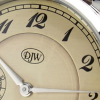A word of warning here.
In many Omega crystals the ring was relieved to fit around and center the dial. The outer edge of the ring will be level with the edge of the crystal, but the dial is slightly smaller and fits into the inner relieved area that is recessed. If you press a new crystal with a solid ring all the way home, you will crush the edge of the dial with the tension ring.


